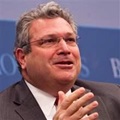
- Madiha Afzal
- Daniel L. Byman
- Samuel Denney
- Kemal Kirişci
- Suzanne Maloney
- Ryan McElveen
- Michael E. O’Hanlon
- Jeremy Shapiro
- Mireya Solís
- Constanze Stelzenmüller
- David G. Victor
- Tamara Cofman Wittes
- See More
The world is a vastly different place today than it was four years ago; so too are America’s relations with allies, adversaries, and institutions. Whoever wins next week’s presidential election will face an ongoing pandemic and the economic and social devastation it has brought, persistent conflicts in the Middle East, deeply strained relations with Europe, and a worsening climate crisis. He’ll face opportunities, too, including the chance to make highly consequential and hopefully constructive choices on China, international trade, and post-COVID recovery. He’ll have alliances that remain intact albeit frayed, and a highly capable U.S. military that has been successfully reorienting toward stronger deterrence of China and Russia.
The next president, whoever he is, will need smart, specific, actionable policy ideas at his fingertips to navigate a fraught international environment. Here, Brookings Foreign Policy experts offer 19 concrete ideas. For literally hundreds more, check out all our research.
Asia
Pursue deeper trade ties with Taiwan.
 Richard C. Bush, Nonresident Senior Fellow in the Center for East Asia Policy and the John L. Thornton China Center
Richard C. Bush, Nonresident Senior Fellow in the Center for East Asia Policy and the John L. Thornton China Center
The next administration should immediately begin exploratory talks with Taiwan on negotiating a bilateral trade agreement. Or, as an alternative, it should begin negotiations on a series of agreements on trade and investment that cumulatively would be the functional equivalent of a bilateral trade agreement.
Join the Comprehensive and Progressive Trans-Pacific Partnership.

 David Dollar, Senior Fellow in the John L. Thornton China Center, and Mireya Solís, Senior Fellow and Director of the Center for East Asia Policy
David Dollar, Senior Fellow in the John L. Thornton China Center, and Mireya Solís, Senior Fellow and Director of the Center for East Asia Policy
We propose that the United States rejoin the Comprehensive and Progressive Trans-Pacific Partnership (CPTPP). After President Trump pulled out of the original TPP, Japan played a leading role in maintaining an ambitious trade agreement among the other 11 Asia-Pacific members. The remaining members were able to maintain the vast majority of the TPP agreement, only turning off a few provisions, such as extended pharmaceutical patents, that were pushed only by the U.S.
Rejoining TPP would serve multiple purposes: 1) it would strengthen U.S. relations with our largest ally in Asia, Japan, and signal that the U.S. is not withdrawing from the Asia-Pacific but rather reengaging; 2) the U.S. and Japan together would be in a good position to lead further expansion of the membership, to include South Korea, Indonesia, Thailand, and other Asia-Pacific economies, creating a powerful bloc of like-minded countries; 3) because the CPTPP covers issues such as cross-border data flows, intellectual property rights protection, trade in services, investment, subsidies, and state enterprises, it is the ideal vehicle to delineate our trade differences with China, which will either have to adapt to these rules or be left out of the largest trade agreement in the region; 4) joining the CPTPP would provide an effective platform to develop trusted supplier networks; and 5) this would be an opportunity for the new Congress to decide what are acceptable new trade agreements for the U.S. For example, the new Congress may prefer to accept the CPTPP compromise on pharmaceutical patents rather than push for the original U.S. position. As in the case of the new North American Free Trade Agreement (NAFTA), Congress may want to strengthen labor and environmental provisions.
It will be tempting for a new Congress to stay away from a contentious issue like trade, but that would be a mistake, because our partners in the Asia-Pacific and around the world will be looking for a restoration of U.S. leadership in creating an open, rules-based economic order.
Join the China-initiated Asian Infrastructure Investment Bank.
 Jamie P. Horsley, Visiting Fellow in the John L. Thornton China Center
Jamie P. Horsley, Visiting Fellow in the John L. Thornton China Center
As an avenue of constructive cooperation to help stabilize the rocky U.S.-China relationship and enhance the U.S. economic presence in Asia, the United States should join the China-initiated Asian Infrastructure Investment Bank (AIIB). The AIIB, whose 103 members include U.S. allies in Asia and Europe, adopted and is improving governance standards that generally comport with internationally-recognized norms practiced by the traditional multilateral development banks (MDBs). Two former U.S. government officials currently serve on its International Advisory Panel. Since opening its doors in January 2016, the AIIB is helping to fill a $26 trillion gap in much-needed infrastructure in Asia through 2030. A modest player to date, it is cautiously expanding its lending portfolio, often in conjunction with other MDBs, as it gains experience.
AIIB membership would afford an additional platform for the U.S. to engage with China to strengthen infrastructure governance standards and enhance transparency for AIIB-financed projects and more broadly, including under its Belt and Road Initiative (BRI). The BRI, decentralized and entrepreneurial to date, has been prominently funded by opaque Chinese policy and commercial banks — not the AIIB — with inadequate attention to financial, social, and environmental sustainability.
Both Chinese-led initiatives have helped spur welcome international efforts — and healthy competition — to address the infrastructure funding gap. The European Union, Japan, and other international donors have enhanced high-quality, infrastructure-driven programs and many are now collaborating on qualified BRI projects, even though they are not BRI “members.” The U.S. in 2019 established the International Development Finance Corporation (DFC) in part to counter China’s BRI, and now claims over 800 projects. It announced the Blue Dot Network that, together with Australia and Japan, certifies high-standard infrastructure projects to facilitate financing. All these efforts bring additional capital and international expertise to help provide sustainable infrastructure to spur economic development and political stability around the globe. They also afford opportunities for American businesses to supply engineering, design, and other project-related services and equipment, and for American nongovernmental organizations to assist project host countries to improve governance to better manage foreign-involved development projects. U.S. cooperation with China on qualified projects financed under AIIB or through the BRI would further expand U.S. business opportunities.
China’s leadership has committed to upgrade and multi-lateralize the BRI to meet international and partner country complaints concerning sustainability, transparency and governance, as well as to welcome more private sector funding and project participation. With China’s slowing economy, focus on controlling fiscal risks at home and abroad, and sensitivity to international skepticism even among some BRI partners, an overture by the U.S. to cooperate with China through AIIB membership, and potential collaboration with an upgraded BRI on qualified projects, would help steady the U.S.-China relationship and signal Asian and other countries they need not choose between working with either the U.S. or China on beneficial projects, while helping to address the global infrastructure gap, improve global infrastructure governance, and create more opportunities for private American participation.
Restore the Peace Corps and Fulbright programs in China.

 Cheng Li, Senior Fellow and Director of the John L. Thornton China Center and Ryan McElveen, Associate Director of the John L. Thornton China Center
Cheng Li, Senior Fellow and Director of the John L. Thornton China Center and Ryan McElveen, Associate Director of the John L. Thornton China Center
Amid a year of stormy seas in U.S.-China relations — with undulating waves of trade tensions, expulsions of journalists, and closures of diplomatic consulates — the Trump administration’s efforts to eliminate educational and cultural exchanges have only worsened the standing of the United States in its most important bilateral relationship.
While the list of measures undertaken to decouple the United States from China is extensive, perhaps the greatest blows to people-to-people relations came with the successive cancellations of the Peace Corps and Fulbright programs in China — programs that, at their core, enhance mutual understanding and promote peace.
Born out of the hopes of Senator J. William Fulbright for sustained peace following World War II, the first Fulbright agreement with any nation was signed with China in 1947. Soon after the Communist takeover, the program shut down in 1950, but it was restarted again in 1979. Over the last 40 years, the U.S.-China Fulbright programs have hosted over 3,000 Americans and Chinese participants to pursue teaching or other academic exchanges in both countries.
The Peace Corps, founded by President John F. Kennedy in 1961 to help improve relations with developing nations, expanded in 1993 to China, the first Communist country to host a program. Since 1993, the Peace Corps has dispatched 1,300 Americans to serve as English educators in 140 colleges and technical schools in remote and less developed areas of southwest China.
The elimination of these programs will result in self-inflicted blows to American interests. These moves cut off channels for accessing and learning about a complex country at a critical time. Alumni of these programs have gone on to serve the United States and share their China expertise in many capacities, including in the government, the media, nongovernmental organizations, and academia. As Peter Hessler, an award-winning author and Peace Corps alum, has pointed out, former China program volunteers have published no fewer than 11 nonfiction books and numerous articles about the country.
Furthermore, these efforts play into the hands of hard-liners in China who have always viewed these American programs with suspicion. Without the opportunity to speak with, learn from, and become friends with Americans, Chinese people become more likely to embrace growing anti-American nationalism.
Finally, American leverage in China requires outreach to broad constituencies in Chinese society. Cross-cultural dialogue on the issues of democracy and rule of law are more critical now than ever before. The White House should immediately reverse course and reinstate both the Peace Corps and Fulbright programs in China. By forsaking these footholds in the world’s rising superpower, the United States is only shooting itself in the foot.
Pursue an interim deal with North Korea.
 Michael E. O’Hanlon, Senior Fellow and Director of Research for the Foreign Policy program
Michael E. O’Hanlon, Senior Fellow and Director of Research for the Foreign Policy program
Even though President Trump’s outreach to North Korean leader Kim Jong Un ultimately failed, it would be a mistake to return to the President Obama approach of “benign neglect” of North Korea, because there is nothing benign about a country building some half-dozen nuclear weapons per year, while also improving missile-delivery technology. It’s better to think boldly. For example, the next administration should seek an interim deal that would require North Korea to verifiably dismantle all nuclear production capability, while keeping moratoria on nuclear testing and the testing of intercontinental ballistic missiles, in exchange for a partial (but not complete) lifting of sanctions.
Broader Middle East
Stay in Afghanistan until an intra-Afghan deal is achieved.
 Madiha Afzal, David M. Rubenstein Fellow in the Foreign Policy program
Madiha Afzal, David M. Rubenstein Fellow in the Foreign Policy program
The discussion on policy options for Afghanistan often swings to two extremes: either that America should leave Afghanistan now; or that if we choose to stay, we will end up staying “forever.” But there is a middle of the road option that the next U.S. administration should take, one that holds the best chance for guaranteeing a positive outcome for both America and for Afghans: The U.S. should make a commitment to maintaining a troop presence in Afghanistan until an intra-Afghan peace deal is achieved. This would likely mean keeping a few thousand troops in Afghanistan for the next three to five years, during the slow, difficult work of negotiations between Kabul and the Taliban.
This policy option certainly makes for less than dramatic campaign promises and offers little immediate relief for a U.S. political class and population weary of war, but it is the most sensible approach in the long term. Maintaining a troop presence would boost the Afghan government as it seeks to work on a deal with the Taliban — giving Kabul leverage to try to preserve the gains that have been achieved in women’s rights and human rights (with American help) over the past 19 years. If we leave now, Afghanistan will likely plunge into a cycle of violence and civil war. The crisis that will almost certainly ensue will be blamed on America — as it was post-1989. We should be clear that the way things turn out for Afghans will affect America in the long term. Our narrative in the region, and real outcomes — security foremost — are at stake.
There are questions, of course, on what happens to the U.S.-Taliban deal signed in Doha and how the Taliban would react to us staying beyond May 2021, the troop withdrawal date identified in that deal. America has had no troop casualties in Afghanistan since March; we certainly do not want to go back to fighting an active war with the Taliban. I would argue that we should aim to preserve the Doha deal as much as possible, and work through its ambiguities and grey areas often alluded to by Ambassador Zalmay Khalilzad and others in the U.S. government. Enough of the deal has been stretched and violated since February 29, including dates and deadlines, that we should not assume we will be throwing it out by staying beyond May.
This is by no means an argument in favor of “endless war” — which is in itself an unhelpful phrase, as the war has largely wound down for America. This is a policy option that recognizes that it is in our best interest — and that of Afghans — to stick it out just a little longer in Afghanistan. The finish line is in sight.
Reduce the frequency of U.N. Security Council meetings on Israeli-Palestinian issues.
 Jeffrey Feltman, Visiting Fellow in the Foreign Policy program
Jeffrey Feltman, Visiting Fellow in the Foreign Policy program
The United States, like Israel, has long questioned the frequency of United Nations Security Council briefings on Israeli-Palestinian issues. Unlike any other issue on the Security Council agenda, these come up monthly and are vehicles for predictable finger-pointing and sterile political posturing, not real debate. Every month. They feed into the narrative that the U.N. is inherently biased against Israel.
The next U.S. administration should leverage re-engagement with the Palestinians, including restored funding for the U.N. Relief and Works Agency for Palestine Refugees in the Near East (UNRWA) and re-opening of diplomatic missions, with Palestinian acquiescence in shifting the frequency of these briefings from monthly to quarterly (which would fulfill the reporting requirement under Security Council Resolution 2334 of December 2016). This would not preclude the council or any U.N. member proposing additional briefings should there be significant developments, and the Palestinians would still have many U.N. platforms to raise concerns.
Seek a quick, interim accord with Iran to limit its nuclear buildup.
 Suzanne Maloney, Vice President and Director of the Foreign Policy program
Suzanne Maloney, Vice President and Director of the Foreign Policy program
Managing the public health catastrophe of the COVID-19 pandemic and the economic devastation that it has wrought around the United States and elsewhere in the world will necessarily occupy the highest priority for the next American president. But whether President Donald Trump remains in the White House or former Vice President Joe Biden takes office, the next administration will also have to grapple with the crises around the world, many of which have been exacerbated by badly designed policies over the past four years.
One of the most urgent of these is Iran. When Trump took office in 2017, Iran was complying with an agreement that was the product of years of hard-fought negotiations to curb its previously steady progress toward nuclear weapons capability. The deal was imperfect, but it was serving its intended purpose — ensuring that a regime that has terrorized its own people and its neighbors could not acquire the most dangerous weaponry. Trump’s 2018 decision to walk away from the Iran nuclear deal — formally the Joint Comprehensive Plan of Action, or JCPOA — has eroded those restrictions and advanced Tehran’s nuclear “breakout” timeline from one year to perhaps as little as 3.5 months. And while his “maximum pressure” strategy reduced the resources available to the Iranian leadership for regional malfeasance, it has not compelled Iranian leaders to embrace new negotiations. This policy has set back American interests in the Middle East, and the collateral damage for 80+ million Iranians who have no say in their government’s national security decisionmaking has been brutal and monumentally counterproductive.
In contrast to campaign rhetoric from both Trump and Biden, there is no quick or easy fix to this predicament. Sustained, careful diplomacy will be required to rebuild confidence among the United States and the other parties to the deal, and to move both sides toward compliance with their original obligations under the nuclear agreement. The United States and its partners must also use any diplomatic process with Tehran to address the deficiencies in the original nuclear deal, by seeking to extend and expand some of the restrictions on Iran’s related activities. For their part, Iranian leaders have demanded compensation for the billions of dollars of trade, investment, and growth that it lost as a result of Washington’s exit from the agreement. The next U.S. president should seek a quick, interim accord with Iran with provisions that once again restrain Iran’s accumulation of fissile material and provide some measure of sanctions relief to its beleaguered economy. And then he should invest in the painstaking, complicated negotiations ensure a more durable resolution to the threats posed by Tehran, including building bipartisan support at home to ensure that any agreement will not be undermined by America’s own domestic politics. It is an extremely tall order, at a time of intensely competing demands, but the alternatives are vastly suboptimal.
Stop arming Saudi Arabia.
 Bruce Riedel, Senior Fellow in the Center for Middle East Policy
Bruce Riedel, Senior Fellow in the Center for Middle East Policy
The Unites States should cease arms sales to Saudi Arabia. The Saudi-led war in Yemen is a quagmire that has led to the worst humanitarian catastrophe in the world, with thousands of Yemenis malnourished. By cutting off arms sales and the delivery of spare parts, upgrades, and munitions for already delivered arms, the U.S. can put significant pressure on the Saudis to cease hostilities, lift permanently the blockade of Yemen, and fully withdraw all their troops from its territory.
Without American arms supplies and logistical support, the Saudi military will be impotent. The U.S. provides two-thirds of the aircraft in the Saudi air force (the United Kingdom provides most of the remainder).
Washington has sold the Saudis over $140 billion in arms since President Barack Obama and Vice President Joe Biden took office in 2009. Most of it occurred during their first administration, in a gigantic deal negotiated by Secretary of Defense Robert Gates. The Trump administration has promised big arms deals with Riyadh, but most of deals it has concluded have been for munitions — not new weapons platforms.
The Obama administration backed the Saudi war in Yemen primarily to discourage active Saudi opposition to the nuclear deal with Iran. But the war has only increased Iranian influence with the Houthi Zaydi Shia rebels in Yemen. The war costs Riyadh a fortune, while Tehran spends a pittance. The Houthis have turned to Iran for expertise in developing missiles and drones, which they use to attack Saudi military installations, oil infrastructure, and cities, especially along the border with Yemen.
The Saudi war is the brainchild of Crown Prince Muhammad bin Salman, who rushed into the war without a strategy or a realistic end game in mind. The crown prince has no experience or training in military affairs and has not visited the battlefield in the five years of fighting. Almost all of the partners who joined in the war then have now deserted him, including the Emiratis.
Yemen’s other neighbor, Oman, refused to join the war from the beginning. The United States should increase its financial and military support to Oman and encourage the Omanis to use their influence in Sana’a and Tehran to end the war. Muscat’s new sultan, Haitian bin Tariq, should be an early visitor to the White House in the next administration.
American troops in Saudi Arabia should also be brought home. The Trump administration sent troops to the kingdom after President George W. Bush brought them out in 2003. Their presence in the kingdom is an implicit endorsement of the war.
Ending arms sales and deliveries to Saudi Arabia and withdrawing American troops should be part of a broader effort to demilitarize American policy in the Persian Gulf. We will still have sufficient bases and troops deployed in the Gulf states — from Kuwait to Oman — to fight terrorism and deter Iranian aggression. The emphasis should be to turn from a militarized approach to the region’s problems to one that emphasizes diplomatic engagement. Reaching out to Iran to revive the dialogue Obama created is a crucial step, which would be enhanced by distancing the U.S. from Saudi Arabia.
Don’t appoint a new high-level Israeli-Palestinian envoy or seek to launch a new round of peace talks.
 Tamara Cofman Wittes, Senior Fellow in the Center for Middle East Policy
Tamara Cofman Wittes, Senior Fellow in the Center for Middle East Policy
The United States should not appoint a new high-level Israeli-Palestinian envoy or seek to launch a new round of Israeli-Palestinian peace talks.
There have been no substantive engagements between Israeli and Palestinian negotiators on a final-status agreement in years, and in the absence of diplomatic progress, the situation between the parties on the ground has deteriorated. Hundreds of thousands of settlers now live beyond Israel’s 1967 borders. A majority of the Israeli parliament is prepared, in principle, to support unilateral annexation of West Bank territory. Palestinian governing institutions are eroding, opaque, and unaccountable, while the Palestinian political leadership and people are divided between an extremist Hamas in Gaza and a weakening Fatah-led Palestinian Authority (PA) in the West Bank. Economic and political inequality between Israelis and Palestinians, most starkly in Gaza, further exacerbates the conflict between them. And as Israelis and Palestinians increasingly live in separate spaces where they rarely interact anymore, the views on all sides of the conflict are hardening.
The Trump administration has fundamentally undercut the U.S. role in Israeli-Palestinian peacemaking by taking a one-sided approach, rejecting core principles that have underlaid Arab-Israeli peace for decades, and aligning the United States with Israeli far- right policies while freezing out the Palestinians. But U.S. policy in the pre-Trump era, under Presidents Bill Clinton, George W. Bush, and Barack Obama, also failed to produce lasting peace, and a simple return to those policies will not succeed.
Addressing the Israeli-Palestinian conflict will remain a U.S. interest for future administrations, but even within the region, the issue is less central to U.S. calculations. While significant segments of the region’s population continue to view the conflict as important, the recent Israel-Bahrain and Israel-United Arab Emirates agreements make clear that resolving the Israeli-Palestinian conflict is no longer a sine qua non for Arab governments.
But avoiding a fruitless negotiating effort does not mean the United States should sit on its hands, or leave the parties to their own devices. The administration should focus on concrete steps to 1) preserve the viability of a two-state outcome, still the outcome most widely accepted locally and internationally and still more available than other proffered alternatives; 2) give future negotiations a stronger foundation for success by engaging across Israeli and Palestinian society and politics; and 3) advance greater security, freedom, and prosperity now for all Israelis and Palestinians living between the Jordan River and the Mediterranean Sea, regardless of when peace negotiations might resume.
Europe
Extend New START with Russia.
 Frank A. Rose, Senior Fellow and Co-Director of the Center for Security, Strategy, and Technology
Frank A. Rose, Senior Fellow and Co-Director of the Center for Security, Strategy, and Technology
The United States and Russia should extend the New Strategic Arms Reduction Treaty (New START) by five years. This will allow both nations to maintain stable nuclear deterrence in the near- to mid-term. However, the two sides should use the time provided by the extension to design a new arms control and strategic stability framework that incorporates new actors like China and emerging technologies like outer space and cyber. Updating the current arms control and strategic stability framework to address the emerging security environment will be critical to the regime’s long-term viability.
Propose a U.S.-EU carbon free trade zone.
 Jeremy Shapiro, Nonresident Senior Fellow in the Center on the United States and Europe
Jeremy Shapiro, Nonresident Senior Fellow in the Center on the United States and Europe
Depending on the outcome of the presidential election, the issue of climate change may represent a critical new priority for the United States. The U.S. would not be alone in this effort. The European Union is in the process of adopting a “European Green Deal” that in many ways resembles the climate proposals of at least one of the U.S. presidential candidates.
As part of the European Green Deal, the EU is proposing to implement a carbon border adjustment mechanism (CBAM) designed to charge imports entering member states based on their carbon content. The intent of this measure is both to encourage other countries to adopt similar efforts to de-carbonize and to protect the competitiveness of European businesses in face of imports that do not bare similar regulatory burdens. As President of the European Commission, Ursula von de Leyen, has noted: “There is no point in only reducing greenhouse gas emissions at home, if we increase the import of CO2 from abroad. It is not only a climate issue; it is also an issue of fairness towards our businesses and our workers. We will protect them from unfair competition.”
The Trump administration sees the CBAM as protectionist, and it could generate trans-Atlantic trade tensions even with an adminstration even that took climate change more seriously. To turn this risk into an advantage, the next U.S. administration might propose that the U.S. and the EU adopt a common carbon border adjustment regime, forming a sort of carbon free trade zone. The benefits of such an arrangement are relatively clear. It would create a level playing field between the EU and U.S., each one another’s largest trading partner; it would prevent escalation to retaliatory tariffs; and it would renew U.S. ties with Europe on the most imporant issue of the day; and it would further an environmental policy that met both sides’ standards for decarbonization.
But perhaps most importantly, it would allow the U.S. and EU to use their enormous combined economic power (together they represent over 40% of global GDP) to push other countries to adopt similar environmental standards, furthering the dual goal of fair competition and a greener global economy. Other countries could join the carbon free trade zone and escape the CBAM as they met the necessary standards for de-carbonization. Even big emitters, such as Russia and China, might be pushed into environmental concessions by a common carbon border regime.
Of course, finding the necessary regulatory alignment to establish a common border adjustment regime will be enormously difficult. But U.S.-European cooperation remains essential to achieving both sides’ climate change goals, particularly as the global process seems, at best, insufficient. As Anthony Blinken, Biden’s top foreign policy adviser, recently remarked: “We have a very aggressive plan to move on this internationally — not just rejoining Paris, but also working to get our allies, partners and others to raise their ambitions. I’d like to think that’s a place where the U.S. and Europe can lead together.” The single biggest idea for leading together in this way is a U.S.-EU carbon free trade zone.
Propose a new trans-Atlantic bargain.
 Constanze Stelzenmüller, Senior Fellow in the Center on the United States and Europe
Constanze Stelzenmüller, Senior Fellow in the Center on the United States and Europe
The next president of the United States should support a new trans-Atlantic bargain consisting of four elements:
1. A regional division of labor within the alliance, with the bulk of the burden for Europe’s security shifting to Europeans over time — while maintaining the U.S. nuclear deterrent in Europe;
2. A trans-Atlantic trade agreement between the U.S. and the EU (but open to the United Kingdom) that abolishes all tariffs and other trade barriers;
3. A joint U.S.-EU effort on protecting global public goods; and
4. An American-European working group on reinforcing domestic resilience — including by strengthening democracy.
SECURITY AND INTERNATIONAL AFFAIRS
Ratify the U.N. Convention on the Law of the Sea.
 Pavel K. Baev, Nonresident Senior Fellow in the Center on the United States and Europe
Pavel K. Baev, Nonresident Senior Fellow in the Center on the United States and Europe
Rebuilding the badly damaged U.S. international reputation is going to be hard and protracted work, but there is one long-overdue step that will signify a strong start in this effort. The next administration should initiate the ratification of the U.N. Convention on the Law of the Sea (UNCLOS). This is a solid and well-functioning element of international law. The arguments in favor of U.S. accession have been known since the George W. Bush administration attempted it in the early 2000s; the arguments against have gained momentum in the course of U.S. withdrawals from, for instance, the Paris Agreement on climate change or the World Health Organization. Two evolving geopolitical situations shift the balance of these arguments — whatever America’s domestic political party feuds — in the direction of the “yes” cause.
The first shift is the escalation of tensions in the South China Sea, where China has upgraded its bases and aggressively opposed U.S. freedom of navigation operations. The U.S. position is perfectly in line with the ruling of international arbitration tribunal in July 2016, which rejected Chinese claims for territorial waters and exclusive economic zones around its artificially created islets, and for the “nine-dash line” encompassing the whole sea as China’s property. By joining the UNCLOS, the United States would be able to strengthen the legal grounds for its operations and gain greater support from the states facing this sea.
The second demanding situation has developed in the Arctic, where Russia is expanding its military activities and restricting the use of the Northern Sea Route. The U.S. has so far refrained from freedom of navigation operations in the Arctic seas, but the shrinking ice coverage in the summer and autumn navigation period makes them increasingly feasible. The U.N. Commission on the Limits of the Continental Shelf has registered the Russian claim for expanding its shelf by some 1.2 million square kilometers, which overlaps with Danish and Canadian claims. After joining the UNCLOS, the U.S. would be able to submit its own claim — and to strengthen the position that the Arctic remains a crucial and vulnerable part of the global commons.
The next administration may be wary about spending its hard-won political capital on this area, but it would actually gain authority and credibility by making this move.
Fight white supremacist violence abroad.
 Daniel L. Byman, Senior Fellow in the Center for Middle East Policy
Daniel L. Byman, Senior Fellow in the Center for Middle East Policy
A new administration should immediately crack down on white supremacist violence, which last year eclipsed jihadist violence as the predominant form of terrorism in the United States. President Trump himself has often downplayed white supremacist violence, but U.S. bureaucracies like the Department of Homeland Security (DHS) and the Federal Bureau of Investigation (FBI) are slowly moving forward despite discouragement or indifference from on high.
What might a new administration do to more effectively target white supremacist violence? As I’ve written, there are a range of steps, including changing rhetoric, increasing resources for the relevant FBI and DHS offices, and asking more of social media companies. But in a globalized world, this is not enough.
As with fighting jihadist terrorism, keeping the United States safe from white supremacist violence requires acting abroad and coordinating with allies. U.S. white supremacist networks are interwoven with European and other networks, and American radicals find inspiration in the 2011 shootings and bombings of Anders Behring Breivik in Norway and Brenton Tarrant in New Zealand in 2019, among many other foreign attacks. Allies around the world are important for helping de-platform violent extremists, arresting active plotters, and otherwise keeping the movement weak and off-balance. Monitoring groups abroad can also reveal previously unknown individuals in the United States who are seeking help and inspiration from abroad. U.S. technical assistance can also make allies more capable in monitoring and disrupting terrorist groups and otherwise making them safer.
The Trump administration cautiously stepped up efforts to fight white supremacists abroad when it designated the Russian Imperial Movement and three of its leaders as Specially Designated Global Terrorists — an important step forward. A new administration should greatly expand this effort, designating other dangerous white supremacist groups and individuals overseas. These designations criminalize support for the group or these leaders, as is true for Americans who assist al-Qaida or ISIS. This, in turn, makes technology companies, banks, and other institutions far more careful with regard to providing services. It is also a way to arrest and prosecute supporters.
As part of its effort to better fight white supremacy abroad, the United States should also punish states that exploit this cause, notably Russia. Both directly and indirectly, the Russian government backs an array of anti-government and white supremacist groups in Europe and the United States. The Russian government also conducts regular information operations that contribute to polarization in the United States and weaken the legitimacy of U.S. institutions. All this makes the white supremacist message more attractive. U.S. policy towards Russia is likely to change dramatically if Vice President Joe Biden wins the election, and stopping Russian support for extremists should be an important policy objective.
Respect the Blob.
 Robert Kagan, Senior Fellow in the Project on International Order and Strategy
Robert Kagan, Senior Fellow in the Project on International Order and Strategy
Respect the Blob. Learn from the Blob. Love the Blob.
Endorse the Global Compact on Refugees.

 Kemal Kirişci, Nonresident Senior Fellow in the Center on the United States and Europe, and Sam Denney, Senior Research Assistant in the Center on the United States and Europe
Kemal Kirişci, Nonresident Senior Fellow in the Center on the United States and Europe, and Sam Denney, Senior Research Assistant in the Center on the United States and Europe
The next administration should update its refugee policy to meet the unique global challenges posed by COVID-19 and a shaky international refugee architecture. Specifically, it should bolster its leadership by endorsing the Global Compact on Refugees (GCR).
After the end of World War II, overseeing the implementation of the Geneva Convention and the protection of refugees bolstered U.S. leadership of the rules-based international order against its strategic rivals. Today, the number of refugees has steadily grown as conflicts around the globe have increasingly gone unresolved. According to the United Nations High Commissioner for Refugees (UNHCR), their numbers have gone up from roughly 10 million a decade ago to 26 million today. An overwhelming majority of these refugees are in developing countries.
While the causes of these trends are undoubtedly complex, the erosion of a U.S. commitment to and leadership of the international refugee system cannot be discounted. U.S. resettlement numbers have collapsed from nearly 85,000 in 2016 to 18,000 in 2020. The Trump administration’s emphasis on “extreme vetting” exemplifies a refugee policy marked by “bureaucratic sadism.” The Migrant Protection Protocols introduced in 2019 have further restricted access to the United States for asylum seekers and required that they apply for asylum from outside the United States. This practice contradicts the Geneva Convention.
Democratic presidential candidate Joe Biden has promised to reverse the Trump administration’s approach to refugees and asylum seekers and increase yearly refugee resettlement quotas to 125,000. But with a definitive end to the COVID-19 pandemic nowhere in sight, the threat facing refugees and the political stability of their host countries calls for the next administration to go beyond simply restoring the traditional U.S. leadership role on refugees.
The United States should endorse the GCR. Adopted in December 2018, the GCR recognizes that traditional, durable solutions are under challenge and protracted refugee situations are likely to persist. It advocates that the international community work to improve the self-reliance of refugees and the resilience of their host communities to transform refugees from being a humanitarian burden to a developmental and economic opportunity.
The damage wrought by COVID-19 and the evidence that an absent United States makes the world less safe and conflicts worse mean that more U.S. global engagement is needed, not less. Faced with limited resources, a long list of foreign policy challenges, and a deeply fractured domestic political environment yearning for presidential leadership, the next administration’s engagement on refugees in particular and in the world in general must be done in a smart and efficient manner.
A renewed U.S. leadership role through endorsing the GCR would do just that. By spurring other countries and the private sector to shoulder more of the burden in creating self-reliance opportunities for refugees and their host communities, U.S. leadership through the GCR would be a force multiplier in the global effort to protect refugees, while also benefitting local communities through the subsequent economic growth. As the 70th anniversary of the 1951 Geneva Convention Relating to the Status of Refugees approaches in 2021, now is the time to update to U.S. refugee policy.
Strengthen America’s global competitiveness through national service and education at home.
 Tom Stefanick, Visiting Fellow in the Center for Security, Strategy, and Technology
Tom Stefanick, Visiting Fellow in the Center for Security, Strategy, and Technology
U.S. competition with other nations, whether they be like-minded democracies or not, will require a population of Americans that is well-educated. This is widely understood. It is also known that early childhood education sets the trajectory for the growth of individuals as they mature. Early childhood education should be a high priority for the country. Funding will be necessary, but is not sufficient. The teaching profession must be elevated to a high level of regard in the country. One means to do this is to require national teaching service in order to help fill some of the unfulfilled needs of our youngest Americans. National leaders must consistently highlight the value of education and of the teachers that provide it.
Push more climate action in U.S. states and cities to enhance credibility overseas.
 David G. Victor, Nonresident Senior Fellow and Co-Chair of the Cross-Brookings Initiative on Energy and Climate
David G. Victor, Nonresident Senior Fellow and Co-Chair of the Cross-Brookings Initiative on Energy and Climate
No matter who wins next week’s presidential election, climate change isn’t likely to be the immediate priority. That’s one reason why the problem keeps getting worse — other events, like the economy and a pandemic, crowd out political attention.
The next president can help fix that by pushing more climate action in the states and cities — where progress is harder to reverse when the winds in Washington shift.
If Biden wins, that approach will require active measures to authorize and push the states to do more. A waiver that allows California to lead on some air pollution regulations should be solidified so that future administrations find it harder to slow down pioneer states like California. A new economic stimulus under Biden would include a lot more funding for clean energy — pushing those funds to the states will help, as well inviting state electricity regulators to find ways to accelerate cuts in emissions. (Electricity is vital to a decarbonizing economy because, for many applications, it is best to switch to electricity and then focus on cutting emissions from the grid.) Key appointments to the Federal Energy Regulatory Commission can reverse Trump-era rules that have made it harder for the states to act.
If Trump is re-elected, then a heartland strategy on climate change will need to come from the heartland itself. Governors and philanthropists that want the country to make a lot more progress will need to double down on what they are already doing. But we need less talking about how the states and cities are supporting the Paris Agreement and more hard-nosed analysis of what works. In effect, the nation is already running thousands of experiments in an attempt to control emissions; under Trump, thanks to the lack of federal report, those efforts have soared.
The states and cities, to a point, have shown they are willing to act. Just last week, a team of us at Brookings released a major assessment of what’s happening in America’s biggest 100 cities. While half of those cities are doing essentially nothing, the other half has been hard at work — those metro areas offer the models for how to make American policy on climate change more credible. That American leadership is essential to a more effective foreign policy on the climate crisis.
Over the last five administrations in Washington, we have seen five wildly different strategies for addressing climate change because there are limits to what a president can do and because polarization makes it hard to agree on any steady course. The rest of the world doesn’t know where the country stands, and with that confusion it gets a lot harder to convince other nations to accelerate their action as well. That dismal logic of collective action can be fixed with more credible and steady U.S. policy, starting across U.S. society rather than in Washington.
Related Content

Madiha Afzal, Ranj Alaaldin, Daniel L. Byman, Ali Fathollah-Nejad, Jeffrey Feltman, Tanvi Madan, Suzanne Maloney, Michael E. O’Hanlon, Bruce Riedel, Shibley Telhami, Tamara Cofman Wittes
January 3, 2020

David G. Victor, Todd Stern, Sahil Ali, Jeffrey Ball, Rick Duke, Samantha Gross, Christina Kwauk, Nathan Hultman, Jenny Schuetz, Rahul Tongia
September 19, 2019

Ted Reinert, Thomas Wright, Constanze Stelzenmüller, Célia Belin, Giovanna De Maio, Molly Montgomery, Amanda Sloat
May 28, 2019
Authors












The Brookings Institution is committed to quality, independence, and impact.
We are supported by a diverse array of funders. In line with our values and policies, each Brookings publication represents the sole views of its author(s).













Commentary
A list of specific, actionable foreign policy ideas for the next president
October 27, 2020